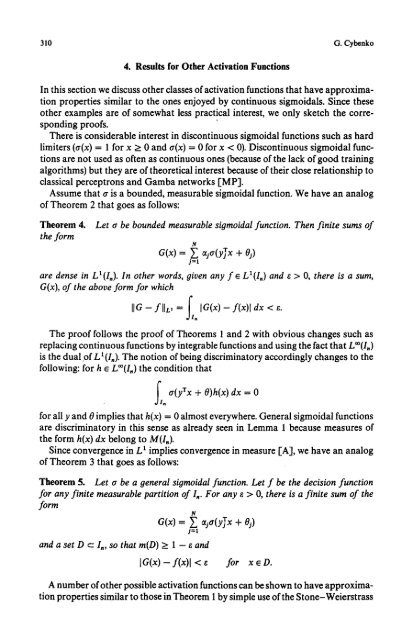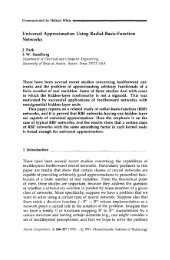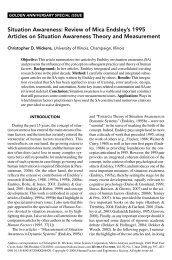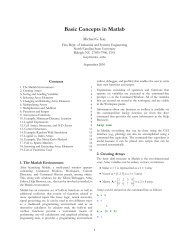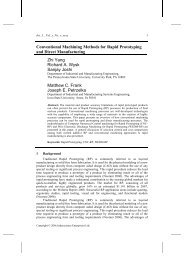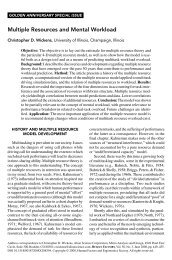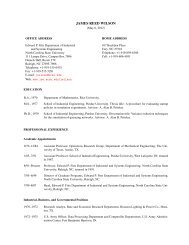Approximation by superpositions of a sigmoidal function
Approximation by superpositions of a sigmoidal function
Approximation by superpositions of a sigmoidal function
Create successful ePaper yourself
Turn your PDF publications into a flip-book with our unique Google optimized e-Paper software.
310 G. Cybenko<br />
4. Results for Other Activation Functions<br />
In this section we discuss other classes <strong>of</strong> activation <strong>function</strong>s that have approximation<br />
properties similar to the ones enjoyed <strong>by</strong> continuous <strong>sigmoidal</strong>s. Since these<br />
other examples are <strong>of</strong> somewhat less practical interest, we only sketch the corresponding<br />
pro<strong>of</strong>s.<br />
There is considerable interest in discontinuous <strong>sigmoidal</strong> <strong>function</strong>s such as hard<br />
limiters (~(x) = 1 for x > 0 and a(x) = 0 for x < 0). Discontinuous <strong>sigmoidal</strong> <strong>function</strong>s<br />
are not used as <strong>of</strong>ten as continuous ones (because <strong>of</strong> the lack <strong>of</strong> good training<br />
algorithms) but they are <strong>of</strong> theoretical interest because <strong>of</strong> their close relationship to<br />
classical perceptrons and Gamba networks [MP].<br />
Assume that tr is a bounded, measurable <strong>sigmoidal</strong> <strong>function</strong>. We have an analog<br />
<strong>of</strong> Theorem 2 that goes as follows:<br />
Theorem 4.<br />
the form<br />
Let tr be bounded measurable <strong>sigmoidal</strong> <strong>function</strong>. Then finite sums <strong>of</strong><br />
Ig<br />
j=l<br />
are dense in LI(I.). In other words, given any f ~ LX(I~) and e > 0, there is a sum,<br />
G(x), <strong>of</strong> the above form for which<br />
/m<br />
JiG - filL, = { ]G(x) - f(x)[ dx < e.<br />
dl n<br />
The pro<strong>of</strong> follows the pro<strong>of</strong> <strong>of</strong> Theorems 1 and 2 with obvious changes such as<br />
replacing continuous <strong>function</strong>s <strong>by</strong> integrable <strong>function</strong>s and using the fact that L~(ln)<br />
is the dual .<strong>of</strong> L t (I,). The notion <strong>of</strong> being discriminatory accordingly changes to the<br />
following: for h E L~176 the condition that<br />
f a(yXx+ O)h(x)dx 0<br />
n<br />
for all y and 0 implies that h(x) = 0 almost everywhere. General <strong>sigmoidal</strong> <strong>function</strong>s<br />
are discriminatory in this sense as already seen in Lemma 1 because measures <strong>of</strong><br />
the form h(x) dx belong to M(ln).<br />
Since convergence in L t implies convergence in measure [A], we have an analog<br />
<strong>of</strong> Theorem 3 that goes as follows:<br />
Theorem 5. Let u be a general <strong>sigmoidal</strong> <strong>function</strong>. Let f be the decision <strong>function</strong><br />
for any finite measurable partition <strong>of</strong> In. For any 8 > O, there is a finite sum <strong>of</strong> the<br />
form<br />
U<br />
j=t<br />
and a set D c In, so that re(D) >_ 1 - e and<br />
IG(x) - f(x)l < for x D.<br />
A number <strong>of</strong> other possible activation <strong>function</strong>s can be shown to have approximation<br />
properties similar to those in Theorem 1 <strong>by</strong> simple use <strong>of</strong>tbe Stone-Weierstrass


